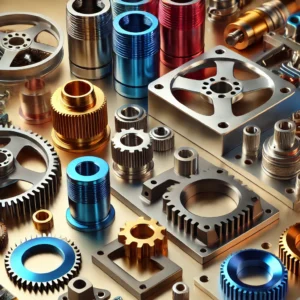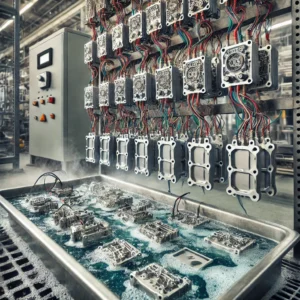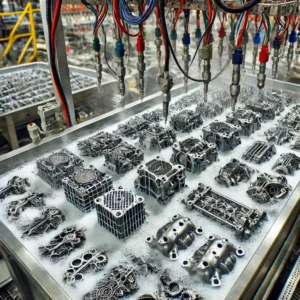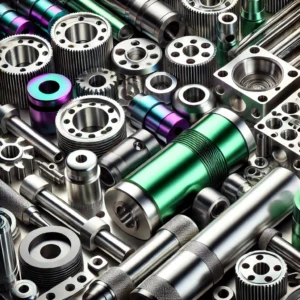Anodised parts is a critical finishing process that enhances the durability, corrosion resistance, and aesthetic appeal of aluminum components. This process is widely used in industries such as automotive, machine building, and automation, where high-quality finishes and robust performance are essential. The anodising process transforms the surface of aluminum, offering both functional and decorative benefits. For businesses seeking precision-engineered anodised parts, working with a reliable CNC machining service is crucial to achieving the desired results.

At CNCRUSH, a leading CNC machining service provider in China with over 12 years of experience, we specialize in CNC Milled parts and CNC Turned parts, providing tailored solutions that meet the stringent demands of industries worldwide. In this article, we explore the anodising process in depth, highlighting the key steps, benefits, and challenges, and why anodising is the preferred finishing technique for aluminum components.
Table of Contents
- What is Anodising?
- Key Steps in the Aluminum Anodising Process
- Advantages of Anodising Parts
- Anodising Aluminum in CNC Milled and CNC Turned Parts
- Comparing Anodising with Other Surface Finishing Techniques
- Applications of Anodised Parts in Automotive, Machine Building, and Automation
- Challenges in Anodising Aluminum Parts
- Sustainability and Energy Efficiency in Anodising
- Choosing the Right CNC Machining Service for Anodised Parts
- FAQ: Frequently Asked Questions about Anodised Parts
1. What is Anodising?

Anodised parts undergo an electrochemical process that creates a protective, durable oxide layer on the surface of aluminum. This process increases the material’s corrosion resistance, hardness, and wear resistance, while also providing the option for colored finishes. Anodising is particularly useful for CNC Milled parts and CNC Turned parts, which are often used in applications requiring high performance and long-lasting durability.
By working with a specialized CNC machining service like CNCRUSH, you ensure that your anodised parts meet the highest standards for both performance and appearance, catering to industries such as automotive, machine building, and automation.
2. Key Steps in the Aluminum Anodising Process

The anodising process involves several precise steps, each designed to ensure the optimal performance of the final product. Below are the key stages involved in anodising aluminum:
- Surface Preparation: The first step involves cleaning the aluminum surface to remove dirt, oils, and oxides that can interfere with the anodising process. This preparation ensures a smooth, even finish on the final product.
- Anodising: The aluminum part is submerged in an electrolyte solution, typically sulfuric acid, while an electric current is applied. This causes the aluminum surface to oxidize, forming a thick, porous oxide layer.
- Coloring (Optional): For applications where aesthetic appeal is important, such as in automotive or consumer electronics, the anodised parts can be dyed during the anodising process.
- Sealing: After anodising, the porous oxide layer is sealed to enhance corrosion resistance. This step is crucial for CNC Milled parts and CNC Turned parts that will be exposed to harsh environmental conditions.
- Quality Inspection: The final anodised parts are inspected for thickness, uniformity, and color consistency to ensure they meet industry standards.
| Step | Description |
|---|---|
| Surface Preparation | Cleaning and degreasing the aluminum surface to remove contaminants. |
| Anodising | Submerging the part in an electrolyte solution and applying electric current. |
| Coloring (Optional) | Dyeing the part for aesthetic purposes. |
| Sealing | Sealing the oxide layer to improve durability and corrosion resistance. |
| Quality Inspection | Inspecting the anodised parts for thickness, uniformity, and color consistency. |
3. Advantages of Anodising Parts
Anodising offers numerous benefits, making it a preferred finishing process for CNC Milled parts and CNC Turned parts used in automotive, machine building, and automation applications:
- Corrosion Resistance: The anodised layer provides a protective barrier against moisture, chemicals, and other environmental factors that can lead to corrosion.
- Surface Hardness: Anodising significantly increases the surface hardness of aluminum parts, making them more resistant to wear and tear.
- Aesthetic Appeal: Anodised parts can be finished in a variety of colors, allowing for customization in consumer products and decorative applications.
- Electrical Insulation: The anodised oxide layer acts as an electrical insulator, which is beneficial for certain electronic components.
- Cost-Effectiveness: Anodising is an affordable finishing option that provides long-lasting durability, reducing the need for frequent replacements or repairs.
| Benefit | Explanation |
|---|---|
| Corrosion Resistance | Protects parts from rust and degradation. |
| Surface Hardness | Increases wear resistance, prolonging the life of the part. |
| Aesthetic Appeal | Allows for a wide range of color finishes. |
| Electrical Insulation | Provides electrical insulation for electronic components. |
| Cost-Effectiveness | Anodising is affordable and long-lasting, reducing maintenance costs. |
4. Anodising Aluminum in CNC Milled and CNC Turned Parts

The anodising process is highly beneficial for CNC Milled parts and CNC Turned parts, especially those used in high-performance applications. Anodising not only enhances the mechanical properties of the parts but also improves their aesthetic appeal, making them suitable for use in automotive, machine building, and automation industries.
At CNCRUSH, we specialize in high-quality CNC machining services, including custom CNC solutions that meet your specific needs. Our expertise in CNC machining aluminum ensures that your anodised parts are durable, precise, and tailored to your industry’s requirements.
5. Comparing Anodising with Other Surface Finishing Techniques
While anodising is a popular surface treatment for aluminum parts, there are several other finishing techniques, such as powder coating, electroplating, and painting. Here’s how anodising compares:
- Durability: Anodising forms an integral layer on the aluminum surface, making it more durable than coatings like paint or powder.
- Maintenance: Anodised parts require less maintenance than other finishes because they resist scratching, peeling, and fading.
- Environmental Impact: Anodising is a more environmentally friendly process compared to electroplating or painting, which can involve harmful chemicals.
6. Applications of Anodised Parts in Automotive, Machine Building, and Automation
Anodised parts are used across multiple industries due to their enhanced properties. Some of the key applications include:
- Automotive: Anodised aluminum is commonly used in lightweight, high-strength components such as chassis parts, engine components, and interior trims.
- Machine Building: Anodised parts in machines are more durable and resistant to wear, making them ideal for heavy-duty equipment.
- Automation: The increased durability and electrical insulation of anodised parts make them suitable for use in automated systems and robotics.
| Industry | Application |
|---|---|
| Automotive | Lightweight chassis, engine parts, and interior trims. |
| Machine Building | Durable machine components for heavy-duty applications. |
| Automation | Parts for automated systems and robotics. |
7. Challenges in Anodising Aluminum Parts
Although anodising is a highly effective finishing process, there are certain challenges that need to be addressed:
- Color Consistency: Achieving uniform color across multiple anodised parts can be challenging, especially in large production runs.
- Surface Defects: Imperfections in the aluminum surface can lead to irregularities in the anodised layer, affecting the final finish.
- Thickness Control: Maintaining consistent oxide layer thickness, especially for CNC Milled parts with complex geometries, requires precise control over the anodising parameters.
8. Sustainability and Energy Efficiency in Anodising
Anodising is considered one of the more sustainable finishing processes due to its lower environmental impact compared to other techniques. The process itself is energy-efficient, and the anodised aluminum can be fully recycled. Additionally, advances in anodising technology have reduced the amount of water and chemicals required, making it a more eco-friendly option for CNC machining services.
9. Choosing the Right CNC Machining Service for Anodised Parts
When selecting a CNC machining service provider, it is essential to consider their expertise in anodising aluminum. At CNCRUSH, we offer comprehensive CNC machining services, including anodising for CNC Milled parts and CNC Turned parts. With over 12 years of experience in the industry, we provide custom CNC solutions that meet the specific needs of industries like automotive, machine building, and automation.
10. FAQ: Frequently Asked Questions about Anodised Parts
Q1: How does anodising improve the performance of aluminum parts?
A1: Anodising enhances the corrosion resistance, surface hardness, and wear resistance of aluminum parts, making them more durable in demanding applications.
Q2: Can anodised parts be used in high-temperature environments?
A2: Yes, anodised aluminum can withstand high temperatures, making it suitable for use in automotive and machine building applications.
Q3: Is anodising environmentally friendly?
A3: Yes, anodising is a relatively eco-friendly process compared to other finishing techniques like electroplating or painting. The anodised layer is fully recyclable, and the process consumes fewer resources.
In conclusion, anodising aluminum is a critical process for improving the performance, durability, and aesthetic appeal of CNC machined parts. If you are looking for high-quality CNC machining services that include anodising, visit CNCRUSH—your trusted partner in CNC Milled parts, CNC Turned parts, and custom CNC solutions.
